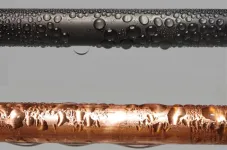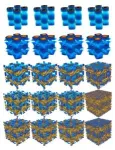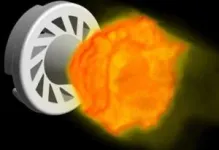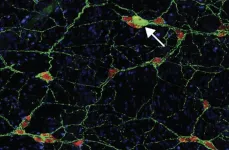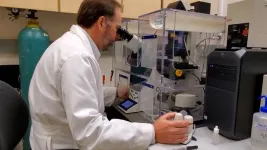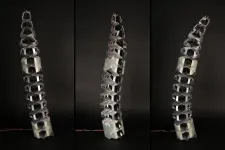(Press-News.org) If coal and natural gas power generation were 2% more efficient, then, every year, there could be 460 million fewer tons of carbon dioxide released and 2 trillion fewer gallons of water used. A recent innovation to the steam cycle used in fossil fuel power generation could achieve this.
Researchers at the University of Illinois Urbana-Champaign have developed a coating for steam condensers used in fossil fuel steam-cycle generation that is made with fluorinated diamond-like carbon, or F-DLC. The researchers reported in the journal Nature Communications that this coating could boost the overall process efficiency by 2%. In addition, they demonstrated the coating’s suitability for industrial use by performing the longest durability test ever reported.
“The reality is that fossil fuels aren’t going away for at least 100 years,” said Nenad Miljkovic, a professor of mechanical science & engineering at UIUC and the project lead. “A lot of CO2 is going to be emitted before we get to a place where we can lean on renewables. If our F-DLC coating were adopted globally, it would noticeably curtail carbon emissions and water usage for the existing power infrastructure.”
Fossil fuel power generation depends on a process called the steam cycle, in which fuel is burned to boil water, the resulting steam spins a turbine and the turbine drives an electric generator. The steam then reaches a condenser which both reclaims water from the steam and maintains a pressure difference across the turbine so the steam flows. Improving the condensers’ heat transfer properties would allow a pressure difference to be maintained while burning less fuel.
The researchers’ new F-DLC coating improves heat transfer because the material is hydrophobic. When the steam condenses into water, it does not form a thin film that coats the surface, like water does on many clean metals and their oxides. Instead, the water forms droplets on the F-DLC surface, putting the steam into direct contact with the condenser and allowing heat to be directly transferred. The researchers found that this improved the heat transfer properties by a factor of 20, which translates to a 2% overall process boost.
“It’s remarkable that we can achieve this with F-DLC, something that just uses carbon, fluorene and a little bit of silicon,” said Muhammad Hoque, a postdoctoral research associate and the study’s lead author. “And it can coat pretty much any common metal, including copper, bronze, aluminum and titanium.”
To demonstrate F-DLC’s durability, the researchers subjected coated metals to steam condenser conditions for 1,095 days, the longest test reported in the literature. The coated metals maintained their hydrophobic properties for this entire length of time. The researchers also found that the coated metals maintained their hydrophobic properties after 5,000 scratches in an abrasion test.
The research team is now collaborating with UIUC’s Abbott Power Plant to study the coating’s performance for six months of steady condensation exposure under industrial conditions.
“If all goes well, we hope to show everyone that this is an effective solution that is economically viable,” Miljkovic said. “We want our solution to be adopted, because, although the development of renewable energy should absolutely be a priority, it’s still very worthwhile to continue improving what we have now.”
***
The researchers’ article, “Ultra-resilient multi-layer fluorinated diamond-like carbon hydrophobic surfaces,” is available online. DOI: 10.1038/s41467-023-40229-6.
F-DLC-coated metals were provided by Oerlikon Balzers Coating.
Researchers from Sabanci University also contributed to this study.
Funding was provided by the Office of Naval Research; the National Science Foundation through the Illinois Materials Research Science and Engineering Center; and the Japanese Ministry of Education, Culture, Sports, Science and Technology.
END
Steam condenser coating could save 460M tons of CO2 annually
2023-08-22
ELSE PRESS RELEASES FROM THIS DATE:
Study adds to evidence that Parkinson’s starts in the gut
2023-08-22
NEW YORK, NY--Ask any neurologist: Parkinson’s disease is a brain disorder. The conspicuous symptoms of Parkinson’s disease—uncontrollable tremors, slowed down motions, and the feeling that one’s feet are stuck to the ground—all stem from the loss of neurons in a region of the brain that helps control movement.
But many researchers believe that the neurodegenerative disorder may get started far away from the brain—in the gut—and years before the first neurological signs appear.
New findings by Columbia researchers David Sulzer, ...
Mapping methane emissions from rivers around globe reveals surprising sources
2023-08-22
Freshwater ecosystems account for half of global emissions of methane, a potent greenhouse gas that contributes to global warming. Rivers and streams, especially, are thought to emit a substantial amount of that methane, but the rates and patterns of these emissions at global scales remain largely undocumented.
An international team of researchers, including University of Wisconsin–Madison freshwater ecologists, has changed that with a new description of the global rates, patterns and drivers of methane emissions from ...
Neuroscientists create new resource to improve Alzheimer’s disease research models
2023-08-22
INDIANAPOLIS – A new study by Indiana University School of Medicine researchers uses more genetically diverse mouse models to study the accumulation and spread of abnormal tau protein deposits in the brain—a known sign of Alzheimer’s disease and several other neurodegenerative diseases. The study’s findings, recently published in the Journal of Experimental Medicine, could lead to better research models that improve understanding of how different genetic backgrounds influence neurodegenerative disease development and treatment needs.
“As ...
Glitter impairs growth of organisms with key roles in aquatic ecosystems, study shows
2023-08-22
A study conducted by researchers affiliated with the University of São Paulo (USP) in Brazil concluded that particles of glitter can hinder the growth of organisms at the base of aquatic ecosystems, such as cyanobacteria (blue-green algae), which play a key role in the biogeochemical cycles of water and soil, as well as being eaten by other organisms. An article on the study is published in the journal Aquatic Toxicology.
Ubiquitous in makeup, nail polish, holiday decorations, greeting cards, Carnival costumes and many other places, glitter sticks to skin and clothes and requires a lot of effort to remove. It is made up of microplastics, tiny particles ...
Mount Sinai study identifies most effective and safest outpatient labor induction methods, potentially reducing hospital stays and increasing hospital efficiency in use of resources
2023-08-22
Paper Title: Outpatient cervical ripening and labor induction with low-dose vaginal misoprostol reduces the interval to delivery: A systematic review and network meta-analysis
Journal: American Journal of Obstetrics and Gynecology, July 2023
Authors: Joanne L. Stone, MD, MSHCDL, Professor and System Chair of the Raquel and Jaime Gilinski Department of Obstetrics, Gynecology and Reproductive Science at the Icahn School of Medicine at Mount Sinai; Rachel Meislin, MD, Maternal-Fetal Medicine Fellow at Mount Sinai Hospital; and other coauthors.
Bottom Line: While prior research and analysis have evaluated methods of outpatient labor ...
NIH awards The Texas Heart Institute $1.14 million to develop a novel, first-in-class drug for atherosclerotic cardiovascular disease
2023-08-22
HOUSTON (Aug. 22, 2023) — The National Heart, Lung, and Blood Institute (NHLBI) recently awarded The Texas Heart Institute® (THI) a two-year, $1.14 million grant to develop a novel, first-in-class drug to treat cardiovascular disease (CVD) as a significant improvement to current treatment regimens — specifically for adverse events arising from atherosclerosis.
Cardiovascular disease is the leading cause of death worldwide, with the Centers for Disease Control and Prevention (CDC) estimating that one person dies from CVD every 33 seconds in the United States, accounting for one in every five deaths in 2021.
CVD leads to heart ...
UT Health San Antonio, 7 collaborators garner $46 million from NIH to move discoveries into practice
2023-08-22
SAN ANTONIO (Aug. 22, 2023) — The University of Texas Health Science Center at San Antonio (also called UT Health San Antonio) and seven regional collaborators will leverage $46 million from the National Institutes of Health (NIH) over the next five to seven years to translate scientific discoveries into therapeutic benefits for human health and well-being.
A key focus will be reducing health disparities among Mexican Americans, active military personnel and veterans.
William L. Henrich, ...
Automate or informate? Firms must invest in specific types of IT to improve working capital management
2023-08-22
The management of working capital — or a firm’s current assets minus its current liabilities — aids organizations in making efficient use of their existing assets and maximizing cash flow.
The relationship between efficient working capital management and firm performance can be complex due to globally dispersed supply chains, number of suppliers and product variety, and technological uncertainty, among other factors.
New research from the University of Notre Dame shows that information technology represents a critical investment that ...
Stealth BioTherapeutics will spotlight latest advancements in mitochondrial medicine at Targeting Mitochondria 2023, Berlin
2023-08-22
BERLIN, Germany – Stealth BioTherapeutics, a front-runner in the world of mitochondrial medicine, is set to unveil its latest breakthroughs at the much-anticipated Targeting Mitochondria 2023 conference in Berlin this October.
Dr. David A. Brown, Vice President of Mitochondrial Research at Stealth BioTherapeutics, is slated to give an enlightening talk titled, “Translational insights from targeting mitochondria in rare diseases.” His presentation promises to provide insights into Stealth’s progress in clinical programs, with updates on their advancements in addressing rare mitochondrial diseases across several Phase 2/3 clinical trials. ...
MIT engineers use kirigami to make ultrastrong, lightweight structures
2023-08-22
Cellular solids are materials composed of many cells that have been packed together, such as a honeycomb. The shape of those cells largely determines the material’s mechanical properties, including its stiffness or strength. Bones, for instance, are filled with a natural material that enables them to be lightweight, but stiff and strong.
Inspired by bones and other cellular solids found in nature, humans have used the same concept ...
